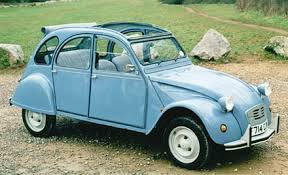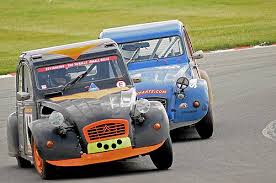Tags
This is generally known as the Citroen Deux Chevaux, but strictly it was the Citroen Deux Cheval Vapeur (2 horsepower), but we’ll let that slide. Anyway, this is what one looks like.
My wife and I had a couple of these in the automotive stable on separate occasions. These were some of the most fun you can have in a car with your clothes on. The first was a slightly foxed, as booksellers have it, pale blue. As with all 2CVs, it had a tubular ‘birdcage’ construction, with the body panels bolted on. Bend something and all you had to do was take it down to the local smithy and have him beat it out again, primer, bit of paint, and away you go. But like a Fiat Panda, a bit flimsy. Not a car you’d use to tackle a 35 ton 16-wheeler truck.
Except that you didn’t have to. True, the tiny flat twin engine was a bit of a sheep in wolf’s clothing – this flat configuration was later hijacked for those mental Subaru Imprezas you can buy these days, admittedly with four cylinders, and by Ferrari, who used even more cylinders and called the engine a ‘boxer’ because it ‘punched’ the power out horizontally. Punching out power was not a charge that could be levelled at the Citroen’s tiddly 600 odd cc (though today’s Smart turbo coupe gives you a lot of performance from about the same size of engine), but it was a willing little bugger. It was best to drive as if the accelerator was an on/off switch. Either you had your foot flat on the gas or flat on the brakes, just like a racing driver; anything else was wasting time.
Despite the skinny tyres, this little motorcar, and its successor 2CV, had reserves of roadholding that defied logic, and if you kept up the momentum it was really hard to beat. On a local roundabout I have overtaken a Porsche 911 Turbo, a BMW M3, and an AMG Merc 600 SLC, all because they underestimated the small dot in the rear-view mirror and I caught them napping in the wrong gear. Pretty embarrassing to have your fifty or sixty or seventy grand’s worth of Teutonic hi-tech musclecar shown a clean pair of heels by a diminutive French peoples’ transport dating from the 1930s. But it can be done.
It didn’t have anything sophisticated such as air conditioning, but it did have front windows that flapped upwards instead of rolling downwards, complete with a little wire prop to keep them in place, a cloth sunroof you could roll all the way back so even rear passengers got the sunshine, and a flap under the windscreen which you could open with a large knurled knob, allowing you to have the biker experience of ‘wind in your hair, flies in your teeth.’
The blue one went to the father of a friend of ours, and its replacement was even better, a bright red and white Dolly Special. Crap name, great car.
Both were flawed in having a pathological reluctance to fire up in the wet. Cold they could handle, but wet weather made them sulk. This was due at least in part to the distributor being mounted directly behind the opening in the front of the bonnet, so ingress of spray was pretty well inevitable. The ignition was also distinguished by having a wasted spark system, which meant that the plugs sparked on both the ignition stroke, as they should, and the exhaust stroke, which most cars do not. This actually simplifies the design of the ignition, but means that the spark plugs work ever so hard for a living and burn out with distressing frequency. We bought swanky platinum-tipped plugs for the Dolly, worth nearly more than the car, but even they tended to wilt after a while.
We went to see some 2CV racing on several occasions. It’s great. They all come piling into the first bend absolutely neck and neck, and doing about 20 mph. When they disappear, you’ve got time to go and get a beer and a hotdog before they finally heave into sight again. A ten lap race lasts forever and a day. What a hoot.



Ha, the 2CV! Small cars are great fun, we used to overtake 4x4s stuck in the sand with my parent’s Renault 4L in the desert, only takes one man to lift it out! (no we didn’t stop to help)
Don’t blame you. All those diddy little cars are too light to sink into the sand, and as you say if the worst comes to the worst you just tuck it under one arm and take it with you. that’s also handy if you can’t find a parking sapce. Just shove it in your handbag and away you go.